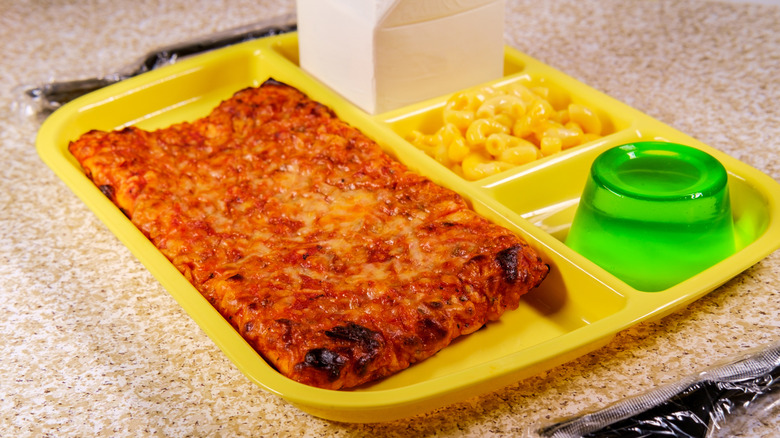What Made Old School Cafeteria Pizza's Spongy Crust So Delicious?
Public school lunches have evolved over the years. School cafeteria menus from the '80s and '90s would raise eyebrows today — even if modern options still leave something to be desired. Tater tots, mac and cheese, hot dogs, and hamburgers were all on regular rotation. But most kids looked forward to Pizza Day — when rectangular slices were served up to the expectant masses — almost as much as recess.
Objectively, that kind of anticipation is a bit perplexing, given the recipe. The toppings included a sauce made with onions, garlic powder, pepper, tomato paste and seasonings. This was then covered in generous portions of shredded cheese, often including (or exclusively) "government cheese," a cost-effective processed cheese with a distinctive flavor that fell somewhere between mild cheddar and Velveeta, and broiled to golden, bubbly perfection. Sometimes, ground beef was added to the tomato sauce or as part of the cheese topping. There's little doubt, though, that the main reason this pizza was so memorable was the spongy, chewy, and addictive crust. And '80s and '90s kids couldn't stop eating it thanks to the unique high-hydration pourable crust with sugar and milk powder.
How old school cafeteria pizza crust got its texture
The most critical component of the old school pizza was a pourable crust used by many school cafeterias. The crust is unique because of its super-high moisture content. If we compare the hydration levels of this crust to focaccia, for example, focaccia has a hydration level of around 80% (already high for a white bread), while this crust hits a whopping 100%-plus. This makes it more of a batter than a dough, and that intense moisture level gives cafeteria pizza an even lighter, airier texture than focaccia — and makes it so much different from the more solid, chewier version we find in most pizzerias.
In addition to the high hydration level, the nonfat dry milk absorbs and retains moisture while browning the crust's exterior, contributing to an ultra-soft interior and light, crispy exterior. The sugar balances any acidity from the other ingredients and also helps with the browning of the crust, yielding a neutral, kid-friendly base for the toppings. And the oven spring seems almost miraculous. Because of the moisture content, what appears to be a thin crust puffs up quickly and profoundly once in the oven, and since there's no kneading or gluten development involved, all the steam it releases helps it bake up light and spongey rather than dense and chewy.
The description of the crust alone is enough to give those who remember it nostalgia-fueled hankerings for Pizza Days gone by.

